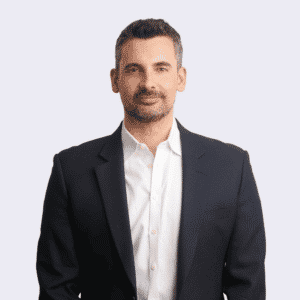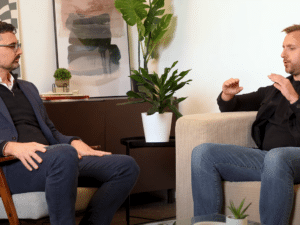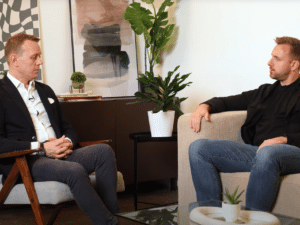How can HR support women in their rise to the top? An interview with best-selling author Jennifer McCollum
Jennifer McCollum’s new book, “In Her Own Voice,” serves as a guiding light in navigating the myriad of challenges obstructing women’s advancement, beautifully interwoven with Jennifer’s personal journey.
Whether you’re looking to get ahead, find direction in your job search, understand how to assess whether an organization is one that allows women to rise to the top or drive change within your own organization, Jennifer’s book is a practical guide and an inspirational read. Her work highlights the hurdles and charts a course towards their elimination.
As I sat in my Chicago hotel room visiting the windy city for a CHRO event, and Jennifer in her home study after months of travelling for her book tour and several keynote speeches, we dove into the genesis of her book and her evolution to CEO.
As a man reading her book, you can’t help but realize the true impact of the hurdles facing women both inside and outside of the workplace. As an HR professional, you’re forced to reflect on your own bias and empowered to think about the opportunity you have to help drive change within your own organization. This book is for everyone, and many of Jennifer’s frameworks and strategies will benefit all of us.
I spoke to Jennifer about three of the eight hurdles her book identifies that women face, to learn her perspective on how HR professionals can support women in their rise to the top.
1. Our inner critic
There is a voice in our head that creates judgment, of ourselves and others: the inner critic.
This voice tends to rise up and talk you or others down when you’re knocked back, in a state of fear or uncertainty, especially in a new experience. It affects men and women differently. The impact of the inner critic on the advancement of men is different; it doesn’t tend to paralyze them or hold them back like it does women.
Mastering your inner critic is a muscle you need to develop and exercise, and Jennifer has a helpful framework for recognizing when this is internal (one down) or external (one up) and what to do about it. She outlines the four steps to take to manage and quiet that inner voice:
Much like in addressing bias, the first step is awareness: recognize when you’re beating yourself up or judging others.
Secondly, pause: you’ve recognized the critic – now stop and take a breath. Thirdly, the hardest step: is to have compassion. Compassion for yourself and when criticizing outwards, compassion for others. Lastly, get curious, ask yourself: what is going on here, and is helping or hurting me or others?
With practice you can learn to quiet the voice of judgment!
2. Cupcakes, culture and courage
How open-minded are you in thinking about your capabilities and potential to achieve? How do you discard the deeply held beliefs that no longer serve you?
There are two types of bias: internal and external. Internal bias is the second hurdle facing women. We need to recognize internal bias and address external bias. We are surrounded by contexts and cultures that reflect external bias. As an example, if we see mostly men at the top of organizations, we then add meaning to this data: “Men have always been the majority in leadership since I joined”. This is where internal bias begins. Jennifer provides insight on how to become aware of your internal biases, how these self-limiting beliefs may be holding you back, and how to talk about them and tackle them.
In the context of HR, how can we help our organizations to recognize and address bias?
Jennifer shared a personal story with me. When she achieved success early in her career, she was described at one point by a colleague as a cupcake with a razorblade inside. It’s a key ‘aha’ moment, as I think we can all agree that there is no world where a man would be described this way. Her manager at the time thought this was a compliment and wasn’t equipped with the skills to challenge this notion.
To create an organization that is capable of bias recognition is to create a culture that isn’t afraid to have hard conversations. Inclusive leadership behaviors foster a culture where employees at all levels are comfortable asking the uncomfortable questions, and driving an open dialogue for mutual learning. Sometimes we all must be a cupcake, and other times a razorblade. If Jennifer’s book tour in the last few months showed her anything, it’s that the world hasn’t advanced on bias as much as we’d hoped. Women approach her after every keynote, sharing their personal stories of being called an iron hand in a velvet glove, a pit bull in a skirt, a bulldozer in a field of daisies…the list goes on.
Awareness comes in moments when others have the bravery to shine a mirror on our biases. When we recognize the bias in ourselves, we are gifted the opportunity to create a culture that allows others to do the same.
One of the ways HR professionals can facilitate that mirror for their leaders and organization is through survey and 360 feedback data. Data gives credibility and insight into the culture and the courage to have those hard conversations and take action, while measuring results over time.
3. Finding clarity
Frazer Jones partners with thousands of female leaders a year, many of whom are trying to find clarity in where they want to take their career long term or even their next career step near term. Finding clarity is about creating intention about your future.
Why is clarity one of the top three hurdles facing women? One hypothesis in the book is that, over time, women have been socialized to meet the needs of others and are not encouraged to focus on themselves, and instead support friends, partners, children and staff. With so much giving and external focus, women can inadvertently fail to create the intention or space for their own clarity to emerge.
Jennifer shared her personal story in finding clarity after leaving two senior corporate positions in the space of 12 months after the first company was acquired and other experienced a leadership shake-up resulting in her role no longer existing. She took a self-imposed sabbatical after working for 20 years straight. She shared a guiding principle during this time which really resonated with me for those looking for their next role: Do one thing every day for your body, one thing for your spirit and one thing for your job search.
Much like successful organizations have a clear vision and strategy, we need this for ourselves. External factors have pulled women further away from this clarity. Jennifer shares specific ways to engage in a personal visioning exercise and establish a clarity statement. Without clarity, it’s difficult to overcome the other hurdles.
Clarity serves as a foundation in your job search, and guides you in where to focus your time and energy. It allows you to attract what you want most in your life and say no to the things that don’t align with helping you achieve that.
In her own voice
Jennifer shares some phenomenal insight into the other hurdles facing women, from proving their value, “making the ask” and networking. She also addresses four dimensions that HR professionals, in particular, can tackle within their organizations to support female leaders in their performance, progression and retention. We’ve touched on culture, but her insight into driving executive action, the right systems and processes and leadership development is invaluable.
When women stand tall in their own voices, they not only overcome hurdles, but also create a ripple effect of empowerment and progress in workplaces.
Jennifer wrote the book based on the data and experience of Linkage, Inc., where she was the CEO from 2018-2023. She begins the next stage in her journey as the new CEO of Catalyst on April 1.
If you’re interested in reading “In Her Own Voice”, you can purchase a copy here.
About Jennifer McCollum

Jennifer is an acclaimed speaker, consultant, coach and author, with two decades of experience leading and building businesses in the leadership space. Her expertise includes how to close the gap to gender equity; why the most effective leaders are inclusive leaders; and how to demystify inclusion for leaders and organizations.
She has delivered workshops, keynotes, webinars, and podcasts to thousands of leaders globally on live and virtual stages. She is a member of the Marshall Goldsmith 100 Coaches, and her book, “In Her Own Voice: A Woman’s Rise to CEO,” was published in November 2023.
Prior to Linkage, Jennifer spent a decade growing businesses within Corporate Executive Board (CEB) – now Gartner, and at Korn Ferry. At CEB, she led product management within the leadership division, driving innovative solutions that helped organizations select, develop and place leaders at all levels. She also ran CEB’s Leadership Academies business, which developed more than 30,000 professionals in 2,100 companies throughout 50 countries and grew revenue at a 97% combined annual growth rate across five years.
Previously, Jennifer served as CEO of IntraVision, a leadership consultancy she founded and grew over the course of 8 years. She worked with public companies, start-ups, associations, and nonprofits. Her passion is creating vision, executing strategy, and managing cohesive teams toward aspirational goals, with a special focus on supporting women in leadership roles.
Jennifer holds an MS in Management and Communications from the University of Stirling in Scotland and a BA in Communications and Psychology from Wake Forest University. She is an avid tennis player and skier, the mother of three and lives in the Washington, DC, area with her husband.



